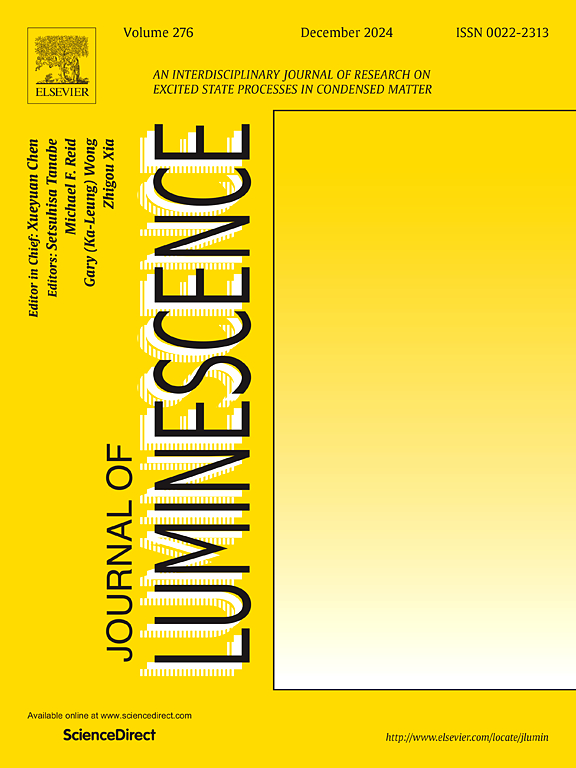用于高性能自供电紫外探测器的ZnO纳米棒阵列上CuSCN的优化电沉积
IF 3.3
3区 物理与天体物理
Q2 OPTICS
引用次数: 0
摘要
采用可控电沉积工艺制备了基于n-ZnO纳米棒阵列/p-CuSCN异质结的自供电紫外(UV)光电探测器。在FTO衬底上水热生长ZnO NRs,然后在0°C和室温(RT)下电化学沉积CuSCN,持续时间(300 ~ 1800 s)。结构表征表明,RT沉积促进了CuSCN的均匀覆盖,提高了结晶度,而0°C沉积导致了稀疏的含杂质晶粒。优化后的RT沉积器件(1800 s)呈现出ii型异质结,界面面积增大,在没有外部偏压的情况下,可在350 nm紫外光照射下进行有效的电荷分离。主要性能指标包括1.57 a /W的高光响应率和快速响应时间,这归功于ZnO/CuSCN界面上的内置电场。这些结果强调了沉积温度和时间在自供电光电应用中定制异质结特性的关键作用。本文章由计算机程序翻译,如有差异,请以英文原文为准。
Optimized electrodeposition of CuSCN on ZnO nanorods arrays for high-performance self-powered ultraviolet photodetectors
Self-powered ultraviolet (UV) photodetectors (PDs) based on n-ZnO nanorod arrays (NRs)/p-CuSCN heterojunctions were fabricated through a controlled electrodeposition process. ZnO NRs were hydrothermally grown on FTO substrates, followed by electrochemical deposition of CuSCN at 0 °C and room temperature (RT) for varying durations (300−1800 s). Structural characterization revealed that RT deposition promoted uniform CuSCN coverage with improved crystallinity, while 0 °C deposition resulted in sparse, impurity-containing grains. The optimized RT deposited devices (1800 s) exhibited a type-II heterojunction with an enhanced interfacial area, facilitating efficient charge separation under UV illumination (350 nm) in the absence of external bias. Key performance metrics included a high photoresponsivity of 1.57 A/W and fast response times, attributed to the built-in electric field at the ZnO/CuSCN interface. These results highlight the critical role of deposition temperature and time in tailoring heterojunction properties for self-powered optoelectronic applications.
求助全文
通过发布文献求助,成功后即可免费获取论文全文。
去求助
来源期刊

Journal of Luminescence
物理-光学
CiteScore
6.70
自引率
13.90%
发文量
850
审稿时长
3.8 months
期刊介绍:
The purpose of the Journal of Luminescence is to provide a means of communication between scientists in different disciplines who share a common interest in the electronic excited states of molecular, ionic and covalent systems, whether crystalline, amorphous, or liquid.
We invite original papers and reviews on such subjects as: exciton and polariton dynamics, dynamics of localized excited states, energy and charge transport in ordered and disordered systems, radiative and non-radiative recombination, relaxation processes, vibronic interactions in electronic excited states, photochemistry in condensed systems, excited state resonance, double resonance, spin dynamics, selective excitation spectroscopy, hole burning, coherent processes in excited states, (e.g. coherent optical transients, photon echoes, transient gratings), multiphoton processes, optical bistability, photochromism, and new techniques for the study of excited states. This list is not intended to be exhaustive. Papers in the traditional areas of optical spectroscopy (absorption, MCD, luminescence, Raman scattering) are welcome. Papers on applications (phosphors, scintillators, electro- and cathodo-luminescence, radiography, bioimaging, solar energy, energy conversion, etc.) are also welcome if they present results of scientific, rather than only technological interest. However, papers containing purely theoretical results, not related to phenomena in the excited states, as well as papers using luminescence spectroscopy to perform routine analytical chemistry or biochemistry procedures, are outside the scope of the journal. Some exceptions will be possible at the discretion of the editors.
 求助内容:
求助内容: 应助结果提醒方式:
应助结果提醒方式:


